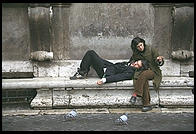
Medieval Rome
by Philip Greenspun; created 1995
The best places to see medieval Rome are around the Campo de' Fiori, with its open-air market and old Jewish quarter, and across the river in Trastevere.
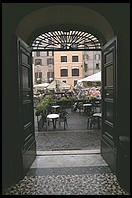
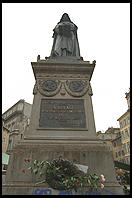 Smack in the center of the square is a statue of Giordano Bruno,
philosopher. Bruno held that God was present in nature and that the universe was
infinite. The Catholic Church burned him at the stake in 1600, right where his
statue is today.
Smack in the center of the square is a statue of Giordano Bruno,
philosopher. Bruno held that God was present in nature and that the universe was
infinite. The Catholic Church burned him at the stake in 1600, right where his
statue is today.
Today the square is best known for its open-air market.
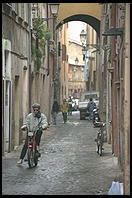
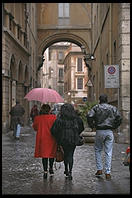 One of the nicest buildings is
the Palazzo Farnese but it isn't open to the public because it is the embassy of
France. This is a source of some bitterness to Romans who complain about the
haughty attitude of the French and naturally they would take one of the city's
best buildings.
One of the nicest buildings is
the Palazzo Farnese but it isn't open to the public because it is the embassy of
France. This is a source of some bitterness to Romans who complain about the
haughty attitude of the French and naturally they would take one of the city's
best buildings.
Walk through the Largo di Torre Argentina, noting the remains of four temples
in the middle. These are from Republican times (4th century BC forward) and they
share the fenced-off ruins area with some blocks from the Curia of Pompey. This
building held a statue of Pompey, sessions of the Roman Senate, and the freshly
killed body of Julius Caesar, stabbed inside on March 15, 44 BC. If you walk
across the Largo to the southeast, you come to the ...
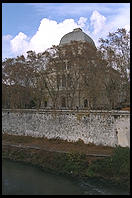 Theoretically there is still a Jewish quarter of Rome where the ghetto used to
be. However, I've never been able to find anything except one Kosher shop and one
synagogue. Jews have a long history in Rome. They arrived as slaves with Pompey
back around 70 BC. Most Jews lived across the river in Trastevere, which was
reserved for foreigners during the Empire, and didn't really move to this side of
the Tiber until the 13th century. They had a few good years there until Pope Paul
IV (1555-59) walled them in; they were allowed out in 1848.
Theoretically there is still a Jewish quarter of Rome where the ghetto used to
be. However, I've never been able to find anything except one Kosher shop and one
synagogue. Jews have a long history in Rome. They arrived as slaves with Pompey
back around 70 BC. Most Jews lived across the river in Trastevere, which was
reserved for foreigners during the Empire, and didn't really move to this side of
the Tiber until the 13th century. They had a few good years there until Pope Paul
IV (1555-59) walled them in; they were allowed out in 1848.
I couldn't really find anything left of the original ghetto walls and the houses inside were demolished in 1888. That leaves a synagogue, finished in 1904. This is reasonably huge but the strict Jewish prohibition against idolatry means the decor is pretty plain compared to the surrounding churches. Other important differences are that the synagogue is surrounded by machine gun-toting cops, you can't bring a camera in due to police security policies, and you have to shell out 8000 lire to get in. The ticket price includes a guided tour and a little museum.
My guide, a spry old lady, told me that "there were so many beautiful churches in Rome that we had to build a beautiful house for God also." She covered the war years briefly. "There were 8000 Jews in Rome. The Germans demanded 50 kilograms of gold as a ransom and promised in exchange not to take any of the Roman Jews to the death camps. We gave them the gold, but a year later they broke their promise and took away 2000 of us." The synagogue also contains the German records of which Jews were taken away to be killed. One American tourist solved an old family mystery with these records. He knew that his father had managed to escape the Germans in Eastern Europe and get to Italy, but didn't know what had become of the man subsequently. The records in the Roman synagogue revealed that he'd been taken to Buchenwald in 1944.
Today there are about 15,000 Jews in Rome, out of a total of perhaps 40,000 in all of Italy (there were 100,000 before World War II). All of the ones I've met are very observant.
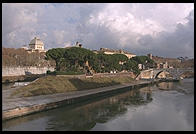 Right next to the synagogue there is a bridge over to a little island in the
middle of the Tiber, Isola Tiberina. Look at the Ponte Fabricio carefully. It was
built in 62 BC and is the oldest surviving bridge in Rome. There isn't much to
see on the island, just a hospital and a church. If you keep walking, you come to
...
Right next to the synagogue there is a bridge over to a little island in the
middle of the Tiber, Isola Tiberina. Look at the Ponte Fabricio carefully. It was
built in 62 BC and is the oldest surviving bridge in Rome. There isn't much to
see on the island, just a hospital and a church. If you keep walking, you come to
...
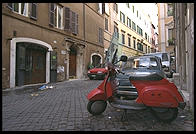 Most of the buildings look like wrecks, but this is the hottest place to live in
Rome right now and one of the very most expensive. During the Republic, this was
a place for foreigners but Augustus incorporated it into the city of Rome. The
big mock naval battles that people think were staged in the Colosseum were in
fact held in a special pool that Augustus built here called the naumachia.
Unfortunately nothing remains of this structure and one is left with several
important churches, a lot of narrow streets, and Pasquino, a theater showing
movies in English.
Most of the buildings look like wrecks, but this is the hottest place to live in
Rome right now and one of the very most expensive. During the Republic, this was
a place for foreigners but Augustus incorporated it into the city of Rome. The
big mock naval battles that people think were staged in the Colosseum were in
fact held in a special pool that Augustus built here called the naumachia.
Unfortunately nothing remains of this structure and one is left with several
important churches, a lot of narrow streets, and Pasquino, a theater showing
movies in English.